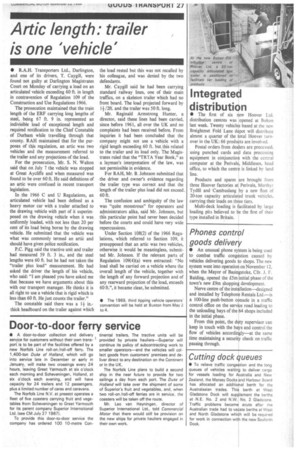Artic length: trailer is one 'vehicle'
Page 29

If you've noticed an error in this article please click here to report it so we can fix it.
• R.A.H. Transporters Ltd., Darlington, and one of its drivers, T. Caygill, were found not guilty at Darlington Magistrates Court on Monday of carrying a load on an articulated vehicle exceeding 60 ft. in length in contravention of Regulation 109 of the Construction and Use Regulations 1966.
The prosecution maintained that the train length of the ERF carrying long lengths of steel, being 67 ft. 9 in. represented an indivisible load of exceptional length and required notification to the Chief Constable of Durham while travelling through that county. RAH maintained that for the purposes of this regulation, an attic was two vehicles and the measurement referred to the trailer and any projections of the load.
For the prosecution, Mr. S. N. Walton said that on July 7 the vehicle was stopped at Great Aycliffe and when measured was found to be over 60 ft. He said definitions of an artic were confused in recent transport legislation.
In the 1966 C and U Regulations, an articulated vehicle had been defined as a heavy motor car with a trailer attached to the drawing vehicle with part of it superimposed on the drawing vehicle when it was uniformly loaded, with not less than 20 per cent of its load being borne by the drawing vehicle. He submitted that the vehicle was what was commonly termed an artie and should have given police notification.
P.C. Pigg said the tractive unit and trailer had measured 59 ft. 3 in., and the steel lengths were 60 ft. but he had not taken the "trailer plus load" measurement. He had asked the driver the length of his vehicle, who said: "I am pleased you have asked me that because we have arguments about this with our transport manager. He thinks it is all right to use a vehicle that is rigid which is less than 60 ft. He just counts the trailer."
The constable said there was a 1+ in.thick headboard on the trailer against which the load rested but this was not recalled by his colleague, and was denied by the two defendants.
Mr. Caygill said he had been carrying standard railway lines, one of their main traffics, on a skeleton trailer which had no front board. The load projected forward by 1+ /2ft. and the trailer was 50 ft. long.
Mr. Reginald Armstrong Hunter, a director, said these lines had been carried, since before 1961, all over the UK and no complaints had been received before. From inquiries it had been concluded that the company might not use a vehicle with a rigid length exceeding 60 ft. but this related to the trailer and its load only. The Magistrates ruled that the "TRTA Year Book," as a layman's interpretation of the law, was not permissible in evidence.
For RAH, Mr. B. Johnson submitted that the driver and owner's evidence regarding the trailer type was correct and that the length of the trailer plus load did not exceed, 60 ft.
The confusion and ambiguity of the law was "quite monstrous" for operators and administrators alike, said Mr. Johnson, but this particular point had never been decided before the courts and could have very wide repercussions.
Under Section 108(2) of the 1966 Regulations, which referred to Section 109, it presupposed that an artic was two vehicles, otherwise it would be meaningless, submitted Mr. Johnson. If the relevant parts of Regulation 109(4)(a) were extracted: "No load shall be carried on a vehicle where the overall length of the vehicle, together with the length of any forward projection and of any rearward projection of the load, exceeds 60 ft.", it became clear, he submitted.
• The 1969, third tipping vehicle operators' convention will be held at Buxton from May 2
to 4.




















































































































